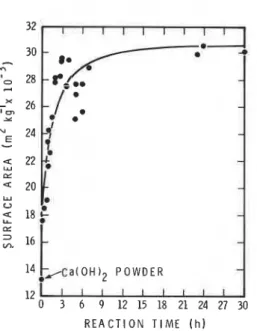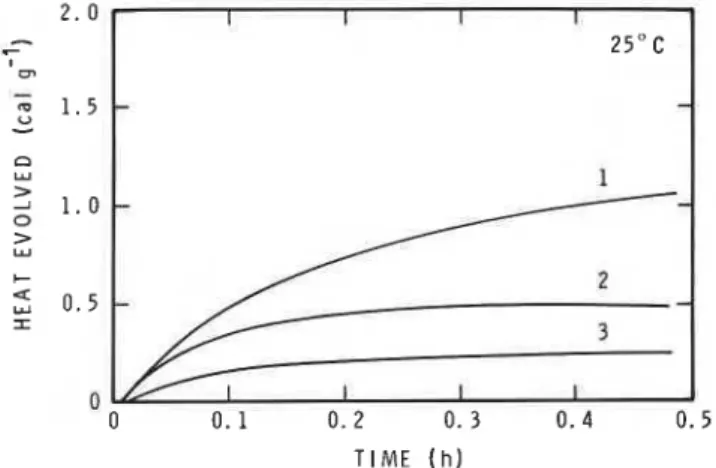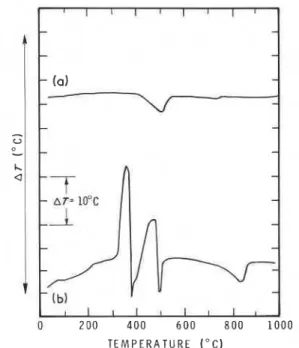Publisher’s version / Version de l'éditeur:
Materials and Structures, 20, 115, pp. 27-31, 1987
READ THESE TERMS AND CONDITIONS CAREFULLY BEFORE USING THIS WEBSITE. https://nrc-publications.canada.ca/eng/copyright
Vous avez des questions? Nous pouvons vous aider. Pour communiquer directement avec un auteur, consultez la première page de la revue dans laquelle son article a été publié afin de trouver ses coordonnées. Si vous n’arrivez pas à les repérer, communiquez avec nous à PublicationsArchive-ArchivesPublications@nrc-cnrc.gc.ca.
Questions? Contact the NRC Publications Archive team at
PublicationsArchive-ArchivesPublications@nrc-cnrc.gc.ca. If you wish to email the authors directly, please see the first page of the publication for their contact information.
NRC Publications Archive
Archives des publications du CNRC
This publication could be one of several versions: author’s original, accepted manuscript or the publisher’s version. / La version de cette publication peut être l’une des suivantes : la version prépublication de l’auteur, la version acceptée du manuscrit ou la version de l’éditeur.
Access and use of this website and the material on it are subject to the Terms and Conditions set forth at
Validity of using methanol for studying the microstructure of cement
paste
Beaudoin, J. J.
https://publications-cnrc.canada.ca/fra/droits
L’accès à ce site Web et l’utilisation de son contenu sont assujettis aux conditions présentées dans le site LISEZ CES CONDITIONS ATTENTIVEMENT AVANT D’UTILISER CE SITE WEB.
NRC Publications Record / Notice d'Archives des publications de CNRC:
https://nrc-publications.canada.ca/eng/view/object/?id=a90dae12-408a-408b-bc1a-c299cf8e9947 https://publications-cnrc.canada.ca/fra/voir/objet/?id=a90dae12-408a-408b-bc1a-c299cf8e9947Ser
TH1
no.
1462
National Research
Conseil national
1
I$
Council Canada
de recherchr Canada
BLDG
-
Institute for
lnstitut de
Research in
recherche en
Construction
construction
Validity of Using Methanol for Studying
the
Microstnrcture
of Cemenf
Paste
by J.J. Beaudoin
Reprinted from
Materials and Structures
Vol. 20, No. 115, 1987
p. 27-31
(IRC Paper No. 1462)
Price $3.00
NRCC 27849
On a effectul des essais afin de determiner l'importance de
l'interaction du mgthanol et de l'hydroxide de calcium
3
22' C.On a utilisd les techniques suivantes
:diffraction aux
rayons
X,
spectroscopie infrarouge, determination de l'aire
superficielle, variation de longueur, calorimgtrie, analyse
thermique diffdrentielle et thermogravimgtrie.
On en a conclu
que du mgthylate de calcium ou un composd m6thyl6 se forme
lorsqu'on m6lange de l'hydroxide de calcium avec du msthanol.
Materials a n d Structures1 Matiriaux et Construction, 1987, 20, 27-3
1
Validity of using methanol for studying the
microstructure of cement paste
J.
J.
BEAUDOIN
Research Oficer, Institute for Research in Construction, National Research Council of Canada, Ottawa, Canada, K I A OR6.
Experiments were conducted to assess the extent of interaction of methanol with calcium
,
hydroxide at 22" C. The following techniques were used: X-ray diffraction, infraredI spectroscopy, surface-area determination, length change, calorimetry, differential thermal . ( analysis and thermogravimetric analysis. It was concluded that either calcium methoxide or
1 - a methylated complex is formed when calcium hydroxide is mixed with methanol.
1.
INTRODUCTION
2.2Specimens
The effect of calcium hydroxide (Ca(OH)2), constitut- ing 26% by volume of cement paste, on the microstruc- ture and mechanical properties of cement paste is not completely understood. Some studies suggest that Ca(OH)2 has good engineering properties and affects the mechanical behaviour of cement paste [I].
Several studies of the microstructure of cement paste describe solvent replacement with methanol (CH30H) as a technique that preserves the "wet state" structure of the material; for example, large decreases in the nitrogen surface area do not result in removal of CH30H [2,3]. An implicit assumption in these studies is that the solvent does not interact with C-S-H or Ca(OH)2, but recent work has indicated that this assumption is incorrect [4].
Opinions differ as to the nature of the CH30H- Ca(OH)2 interaction. The suggestion that CH30H reacts with Ca(OH)2 to form calcium methoxidp, (Ca(OCH3)2) or a carbonate-like product [5] has not been accepted by all investigators [3,6]. It was of interest to establish the nature of the solvent-Ca(OH)2 interaction, as non-aqueous media are often used to characterize cement systems. The results of applying
17
several techniques to the CH30H-Ca(OH)2 system arediscussed.
Ca(OH)2 was used in both compacted and powder form. Powder was compacted at pressures of 345 and 690 MPa to produce circular disks 32 mm in diameter and 1.27 mm thick. To study the interaction of alcohol with Ca(OH)2 powder, both substances were placed in 100-ml glass bottles and stirred continuously. The ratio of liquid to solids by volume was 5 to 1.
2.3
Surface area measurement
Nitrogen surface area measurements were obtained with a Quantasorb surface area analyser.
2.4
Length change
Modified Tuckerman optical extensometers with a sensitivity of 4
x
lop6 mm mm-' were used.2.5
X-ray diffraction
X-ray diffraction data were obtained with a Guinier- Hagg powder camera, Model XDC-700.
2.6
IR spectroscopy
A Nicolet model 6000 fourier transform IR spec- trometer with a mercury-cadmium-telluride detector was used, which had a resolution of 4 cm-l. Compu- tation conditions included one level of zero filling and Happ Genzel apodization.
2.
EXPERIMENTAL
2.7
Thermal analysis
2.1
Materials
Calcium hydroxide (Ca(OH)2): reagent-grade powder with a surface area of 12.0
x
lo3 m2 kgp1. Alcohols: reagent-grade methyl, ethyl and other aliphatic alcohols. Calcium methoxide (Ca(OCH3),): surface area of 60x
lo3 m2 kg-'. This material, for which the XRD and IR spectra matched published spectra [7], was prepared according to procedures described by Robinson and Scott [8].DTA and TGA were carried out using a 1090 Dupont Thermal Analyzer containing a 951 TGA accessory. Both air and nitrogen atmospheres were used. Gener- ally, 20-mg samples were heated at 20" C min-l. 2.8
Conduction calorimetry
The rate and amount of heat development in CH30H- Ca(OH)2 mixtures were measured using a conduction calorimeter. The calorimeter, supplied by the Institute
Beaudoin of Applied Physics, Delft, Holland, has been described
previously [9]. For data acquisition and processing, the calorimeter was interfaced with an Apple IIe using a Taurus One 12-bit analog-to-digital converter, and an Apple super-serial interface card.
3. RESULTS AND DISCUSSION
3.1
X-ray diffraction
Both powdered and compacted samples of Ca(OH)2 were submerged in CH30H for 24 h, dried by pumping in vacuo for 8 h, and prepared for X-ray diffraction measurements. New peaks were observed at d-spacings of 0.834, 0.419,0.291, 0.277 and 0.176 nm. It has been suggested that Ca(OCH3)2 is a possible reaction pro- duct of a CH30H-Ca(OH)2 interaction [ 5 ] . The observed spacings corresponded to those assigned to Ca(OCH3)2 with the spacing at 0.834 nm being very strong. The X-ray pattern, however, did not include the d-spacings for Ca(OCH3)2 at 0.316 and 0.184 nm. Ca(OCH3)2 was also prepared; the d-spacings matched those given in the JCPDS card file.
3.2 Infrared spectroscopy
Infrared spectra of Ca(OH)2, Ca(OCH3)2 and the pro- duct from the C ~ ( O H ) ~ - C H ~ O H interaction are given in fig. 1. Two samples of the Ca(OH)2-CH30H system were obtained by mixing Ca(OH)2 powder in CH30H for 2 and 24 h. The samples were dried by pumping in
vacuo for 8 h. Free CH30H was not detected in either
sample, as concluded from the absence of peaks at 3337 and 1021 cm-l. The 2-h sample had wavenumbers at 3640, 3408, 2591, 1788, 1450, 1098 and 865 cm-l. These peaks were due to the presence of unreacted Ca(OH)2 and what appeared to be early formation of Ca(OCH3),. In addition, the 24-h sample had wave- numbers at 2922, 2837, 2778 and 2098 cm-'. These bands were similar to those present in the IR spectra of Ca(OCH3)2. Although mixed or poor crystallinity could account for some discrepancy with published spectra, the evidence indicated that a new reaction product was formed.
3590 2770 1950 1130 310
W A V E N U M B E R S
Fig. 1 Infrared spectra: Ca(OH)2; Ca(OCH3)2; Ca(OH)2
+
CH30H interacted for 2 h, 1 day.3.3 Surface area
Nitrogen surface areas were determined for Ca(OH)2 samples immersed in CH30H for different periods (fig. 2). The surface area of Ca(OH)2 increased from 13.2 x lo3 to 29.4 x lo3 m2 kg-' in 4 h. Apparently, reaction products with a surface area larger than that of Ca(OH)2 were formed. As previously stated, formation of Ca(OCH3)2 has been suggested. Using the value 60
X
lo3
m2 kg-' as the surface area of Ca(OCH3)2, it was estimated that about 29.0% Ca(OH)2 reacted at 4 h. It is not clear why there was little change in the surface area after 4 h. Possibly, N2 was excluded from the surface that became inaccessible during drying because of ageing or agglomeration effects. However, evidence from thermal analysis (to be presented later) indicated the reaction did not cease at 4 h.1 2 1 1 1 1 1 1 1 1 1 1 1
0 3 6 9 12 15 18 21 24 27 30
R E A C T I O N TIME ( h )
Fig. 2 Nitrogen surface area of Ca(OH)2 samples immersed in methanol for different periods.
Materials and Structures
Increases in the surface area of Ca(OH)2 samples immersed in other aliphatic alcohols were much smaller. Surface areas increased from 13.2 x
lo3
m2 kg-' to 15.47, 14.66, 13.67x
lo3 m2 kg-' in samples treated with ethyl, amyl and butyl alcohol, respectively.3.4
Length change
The length change of compacted samples of Ca(OH)2 (formed at 345 MPa) immersed in CH30H and ethanol is plotted in fig. 3. Length change of the samples was much greater in CH30H, increasing to 0.27% after \ 45 h. The length change in ethanol was small, increas- ( ing to only 0.02% after 20 h. The length change of I. Ca(OH)2 in water (not shown) was about 0.2%. The
large length change in CH30H may have been due to several factors. The formation of Ca(OCH3), results in the release of water as a reaction product. This water may interact with unreacted Ca(OH)2, thereby contri- buting to the length change. The length change of Ca(OH)2 in water is attributed to physical adsorption at low humidities, and dissolution and recrystallization at points of solid contact when the humidity is higher [lo].
TlME ( h )
,
Fig. 3 Length change of calcium hydroxide compacts im-mersed in methanol and ethanol.
Expansion may also be caused by pressure resulting from the increase in specific volume of the reaction products; for example, Ca(OCH3)2 has a specific volume of 0.575 cc g-l. The larger surface area of the reaction products would also result in increased length change due to physical adsorption. Another factor may be the release of strain energy from the Ca(OH)2 parti- cles after interaction with CH30H; if so, the small length change in ethanol suggests that there is little interaction between ethanol and Ca(OH)2.
3.5 Conduction calorimetry
Heat evolution versus time curves for CH30H and ethanol plus Ca(OH)2, and CH30H plus calcium carbonate, are plotted in fig. 4. In each test, 10 ml of
TlME ( h )
Fig. 4 Heat evolved versus time curves - (1) methanol, and
(2) ethanol, plus calcium hydroxide; ( 3 ) methanol plus cal- cium carbonate.
solvent was mixed with 5 g of sample. The test tem- perature was 25 f 0.001" C. The heat developed in the CH30H-Ca(OH)2 system was much greater than in the other two systems and even exceeded the heat of disso- lution in the Ca(OH)rH20 system (not shown). The amount of heat developed in the CH30H-calcium- carbonate and CH30H-titanium-oxide (not shown) systems was similar and consisted primarily of heats of stirring and wetting. Surface areas of the solids in all four systems were similar. The greater heat developed in the CH30H-Ca(OH)2 system may have been the result of a chemical interaction.
3.6 Thermal analysis
DTA experiments were conducted (in air and nitrogen) on CH30H-treated Ca(OH)2 samples to determine whether a reaction between CH30H and Ca(OH)2 had occurred. Curves for experiments conducted in air are presented in fig. 5. The first curve for Ca(OH)2 has a large endotherm at about 500" C. A small amount of carbonation is evident from the endothermal peak at 720" C.
In the second curve in fig. 5, which is for the CH30H-treated Ca(OH)2 system (3-day interaction time), there are large exothermic peaks at 330 and 450" C. Other curves for this system (not shown) obtained at different interaction times exhibit exother- mic peaks at 370, 400 and 485" C. The intensity and position of the peaks are dependent on interaction time. It is difficult to assign these exothermic peaks to Ca(OCH3)2 because Ca(OCH3)2 interacts with Ca(OH)2 during a DTA cycle.
A set of TGA curves (not given) was obtained for samples of Ca(OH)2 that were mixed with CH30H for increasing lengths of time. Weight loss at 600 to 800' C in air for these Ca(OH)2-CH30H preparations is plot- ted against reaction time in fig. 6. The increase in weight loss from 3.2% to more than 20% after 12 h confirms the findings of Day, who suggested the forma- tion of a "carbonate-like" product [5]. The carbonate- like product is actually CaC03 formed from the
Beaudoin
T E M P E R A T U R E ( " C )
Fig. 5 DTA curves (in air) for (a) Ca(OH)2 and (b) Ca(OH)2
+
C H 3 0 H interacted for 3 days.0 2 4 6 8 10 12 14 16 18 20 l N T E R A C T I O N T I M E ( h )
Fig. 6 Weight loss due to decomposition of CaC03 formed during TGA of samples produced by interacting Ca(OH)2 and methanol for different time periods.
decomposition of the reaction products. Weight loss at
600 to 800" C for the Ca(OH)2-Ca(OCH3)2 mixtures
heated in air increased with the amount of Ca(OH)2 in the mixture. In nitrogen, weight loss was maximum for mixtures with equal parts of Ca(OCH& and Ca(OH)2. It appears that C 0 2 liberated on the decomposition of Ca(OCH3)2 may form additional CaC03 by reacting with Ca(OH)2. The amount of carbonate formed would depend on the mixture proportions.
4.
CONCLUSIONS
The following conclusions may be drawn from this study:
1. Evidence provided by several techniques (XRD, IRS, calorimetry, length change, surface area measure- ment, DTA and TGA) supports the hypothesis that CH30H reacts with Ca(OH)2 at 22" C.
2. Similarities between the reaction products and Ca(OCH3)2 were detected by the above techniques. It is concluded that either Ca(OCH3), or a methylated complex is formed when Ca(OH)2 is mixed with
CH30H. .I
3. The implications of a CH30H-Ca(OH)2 interac- I tion should be considered in the development of test
methods for concrete that employ CH30H. 'I
ACKNOWLEDGEMENTS
The author thanks R. E. Myers for conducting the experimental work, G. M. Polomark for his assistance with the thermal analysis, and Dr F. R. S. Clark for providing the infrared spectra. This paper is a contri- bution from the Institute for Research in Construction, National Research Council of Canada.
REFERENCES
1. Beaudoin, J. J., 'A comparison of mechanical properties of compacted calcium hydroxide and portland cement paste systems', Cem. Concr. Res. 13 (1983) 319-324. 2. Litvan, G.G., 'Variability of the nitrogen surface area of
hydrated cement paste', ibid. 6 (1976) 139-144. 3. Parrott, L.J., 'Thermogravimetric and sorption studies of
methanol exchange in an alite paste', ibid. 13 (1983) 1&22.
4. Beaudoin, J. J., 'Mechanisms of subcritical crack growth in cement paste', Proceedings of International Confer- ence on Fracture Mechanics of Concrete, Lausanne, October 1985.
5. Day, R.L., 'Reactions between methanol and Portland cement paste', Cern. Concr. Res. 11 (1981) 341-349.
6. Chandra, S. and Flodin, P., ibid. 12 (1982) 261-262. w
7. Lutz, H.D., 'IR-spektroskopische und rontgeno-
graphische Untersuchungen an Mg(OCH3)2
Ca(OCH3)2, S I - ( O C H ~ ) ~ und Ba(OCH3)2', Z. Anorg. 1 I Allgem. Chem. 353 (1967) 207-215.
8. Robinson, P.L. and Scott, W.E., 'The polysulphides of barium and calcium', J. Chem. Soc. (1931) 693-709. 9. Ramachandran, V.S., 'Action of triethanolamine on the
hydration of tricalcium aluminate', Cem. Concr. Res. 3 (1973) 41-54.
10. Ramachandran, V. S. and Feldman, R. F., 'Length change characteristics of Ca(OH)2 compacts on expo- sure to water vapour', J. Appl. Chem. 17 (1967) 328-332.
Materials and Structures
RESUME
L'utilisation du methanol pour etudier la microstruc- ture de la pite de diment est-elle valable?
O n a extcutt des essais afin de dtterminer l'importance de I'interaction d u mtthanol et de l'hydroxide de calcium
a 22" C . O n a utilist les techniques suivantes: diffraction
X, spectroscopie infrarouge, dttermination de l'aire superficielle, variation de longueur, analyse thermique difftrentielle et thermogravimttrie. Les rbultats de ces essais ont mis en tvidence la formation d'un produit
1 nouveau. O n a observt la prtsence de mtthylate de I calcium dans le diagramme X d'hydroxide de calcium traitt au mtthanol. Pour ce systt?me, les pies I R corres- pondaient aussi a ceux qui se trouvaient dans le spectre I R d u mtthylate de calcium. O n a observt des augmen- tations importantes de I'aire superficielle mesurte par
absorption d'azote et la variation de longueur d'tchantil- Ions d'hydroxide de calcium apres traitement au mttha- nol. E n outre, o n a observt une interaction chimique entre le mtthanol et I'hydroxide de calcium mise en evidence par les courbes tvolution thermique en fonction d u temps obtenues par calorimttrie diffrentielle. Des pics exothermiques de 330 et 450" C dans les courbes
A T D d'hydroxide de calcium traitt au mtthanol indi- quait la formation d'un nouveau compost. Les donntes A T G ont montrt une augmentation en rapport avec le temps de la perte de poids (600 a 800" C ) correspondant
a la dtcomposition d u carbonate de calcium qui rbulte de la formation et de la dtcomposition d u mtthylate de calcium.
I1 faut considtrer les implications de I'interaction mtthanol-hydroxide de calcium dans le dtveloppernent des mtthodes d'essai pour le btton qui utilisent le mtthanol.
T h i s paper


